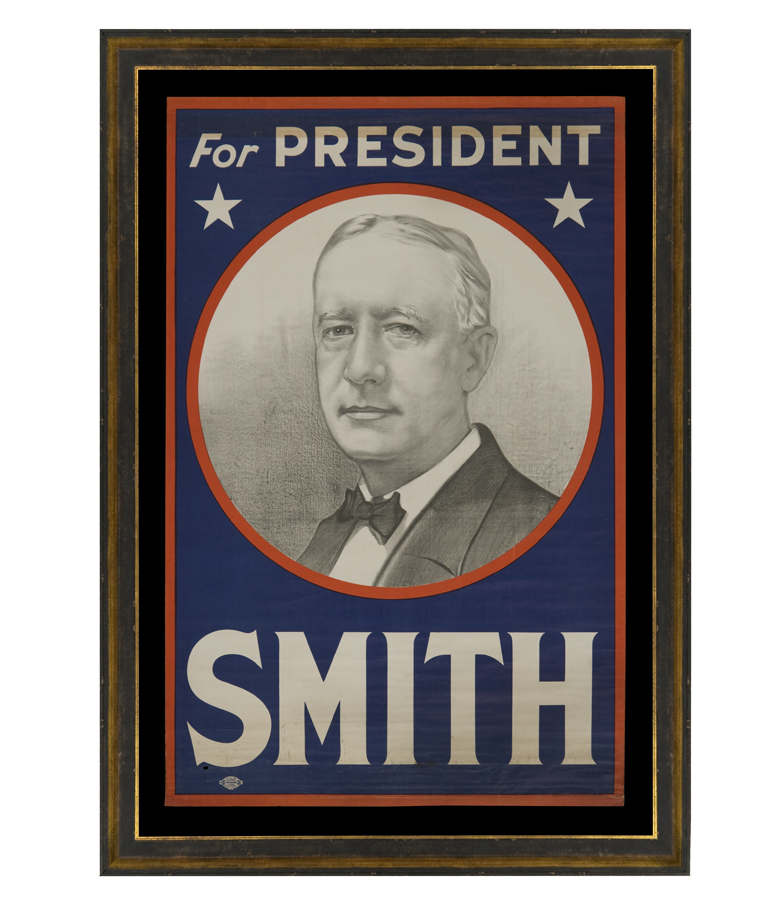


| PRINTED COTTON BANNER, MADE FOR THE 1928 PRESIDENTIAL CAMPAIGN OF NEW YORK ASSEMBLYMAN AND SHERRIF TURNED GOVERNOR, AL SMITH, A LEADING PROGRESSIVE MOVEMENT DEMOCRAT AND THE FIRST CATHOLIC TO RUN FOR THE NATION'S HIGHEST OFFICE ON A MAJOR PARTY TICKET |
|
| Web ID: | pat-167 |
| Available: | In Stock |
| Frame Size (H x L): | Approx. 50" x 71" |
| Flag Size (H x L): | 39" x 60" |
| Description: | |
| Printed in heavy ink on cotton, this rare and colorful campaign banner was made in 1928 to promote the candidacy of New York Governor Al Smith for President of the United States. An argument can be made that the combination of its attractive portrait, tall and narrow form, and strong colors make it superior to any other of its kind made during the entirety of the 20th century. And it is of further interest that Smith, a born-and-bred New Yorker, became one of the more interesting characters among the losers in 20th century American presidential politics. The banner was produced by the Sweeny Lithograph Company in Belleville, NJ and is signed in the lower right. An example of the same variety is held in the collection of the Smithsonian and documented in "Threads of History: Americana Recorded on Cloth, 1775 to the Present" by Herbert Ridgeway Collins (Smithsonian Press, 1979), as item #1060 on page 414. Collins formerly served as Curator of Political History at the Smithsonian Institution and his text is widely agreed to be the best available reference for American political textiles. In his book, Collins notes that the portrait was derived from a half-tone engraving by the Tileston & Hollingsworth Company. A Brief History of Al Smith: Alfred Emanuel Smith, Jr. was born on December 30th, 1873, and grew up on Manhattan's lower east side. His grandparents were of Irish, German, Italian, and English descent, but he most easily identified with the Irish American community and would eventually become its leading spokesman. At age 14, following the death of his father, Smith found himself a high school dropout working at the Fulton Fish Market to support his family. Never finishing high school or college, he claimed to have learned about people by studying them at the Fulton market, which allowed him to later campaign as a man of the people, easily identifying with immigrants. In 1895, Smith became clerk in office of the Commissioner of Jurors. In 1903, he was elected to the New York State Assembly. In 1911, after 146 workers died in the Triangle Shirtwaist Factory fire, he held strong to his roots and was appointed vice chairman of the commission appointed to investigate the fire. Backed by Tammany Hall, he soon became known as a crusader for workers' rights, championing legislation against dangerous and unhealthy work environments. By 1915, Smith was seen as a leader of the Progressive movement in New York City and rose quickly through the political ranks. He was elected Sheriff of New York County in that year, then President of the board of Alderman of the City of New York in 1917, and finally obtained the Governor's chair in 1918. He lost his bid for reelection in 1920 after speaking out against William Randolph Hearst, a sensationalist newspaperman who was the leader of the populist right wing of the Democratic Party and had teamed with Tammany Hall to elect local administration. But he mended this transgression and re-won the governorship in 1922, 1924, and 1926. In 1928 Smith firmly etched his place in American history, when he became the first Catholic to be nominated to run for the Whitehouse on a major party ticket. Though he brought millions of Catholic voters to the polls for the first time, especially women, he lost to Herbert Hoover in the election, mostly due to his outspoken stance against Prohibition and a general fear that he would answer to the Pope before the Constitution. Mounting: The textile has been hand-stitched to 100% cotton twill, black in color. The black fabric was washed to remove excess dye. An acid-free agent was added to the wash to further set the dye and the fabric was heat-treated for the same purpose. The mount was then placed in a black-painted, hand-gilded and distressed Italian molding. The front is U.V. protective acrylic. Condition: Overall excellent. There is very minor foxing, accompanied by very minor splits and losses. The colors are strong and vibrant. The wooden bar once glued to the top is no longer present. |
|
| Video: | |
| Collector Level: | Intermediate-Level Collectors and Special Gifts |
| Flag Type: | |
| Star Count: | |
| Earliest Date of Origin: | 1928 |
| Latest Date of Origin: | 1928 |
| State/Affiliation: | New York |
| War Association: | |
| Price: | Please call (717) 676-0545 or (717) 502-1281 |
| E-mail: | info@jeffbridgman.com |
 |
|